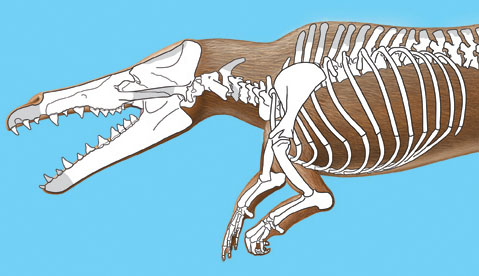Artist's conception of male Maiacetus inuus with transparent overlay of skeleton.
Click on image for full size
Courtesy of John Klausmeyer and Bonnie Miljour, University of Michigan
Early Whales Gave Birth on Land
News story originally written on February 3, 2009
Scientists discovered two fossil
whales in 2000 and 2004 in Pakistan. They dug up the fossils, transported them back to labs, cleaned off the fossils and then worked on the fossils for a few years. Their hard work paid off! Some important findings were made!
The fossils that were found were very old (47.5 million-years-old)! The fossils were actually a female and male primitive whale. And the female was pregnant. It was discovered that the mom whale would have delivered her baby on land. This was during a time when whales came on land to rest, mate and give birth to young.
The whales had big teeth that would have been good for catching and eating fish, suggesting the animals really did spend most of their time in the sea.
Scientists named this primitive whale Maiacetus. This was an important fossil find because it showed one of the important steps that whales took as they made the transition from full-time land animals to ocean creatures.
You might also be interested in:

This Windows to the Universe Exploratour examines the scientific evidence of biological evolution. It is available at the intermediate and advanced levels only. To travel through the tour, click the back
...more
Scientists have learned that Mount Hood, Oregon's tallest mountain, has erupted in the past due to the mixing of two different types of magma. Adam Kent, a geologist at Oregon State University, says this
...more
The Earth's mantle is a rocky, solid shell that is between the Earth's crust and the outer core. The mantle is made up of many different reservoirs that have different chemical compositions. Scientists
...more
Some faults look strong and like they wouldn’t cause an earthquake. But it turns out that they can slip and slide like weak faults causing earthquakes. Scientists have been looking at one of these faults
...more
The sun goes through cycles that last approximately 11 years. These solar cycle include phases with more magnetic activity, sunspots, and solar flares. They also include phases with less activity. The
...more
Studying tree rings doesn't only tell us the age of that tree. Tree rings also show what climate was like while the tree was alive. This means that tree rings can tell us about climates of the past. Two
...more
Earth's first life form may have developed between the layers of a chunk of mica sitting like a multilayered sandwich in primordial waters, according to a new hypothesis. The mica hypothesis, which was
...more















